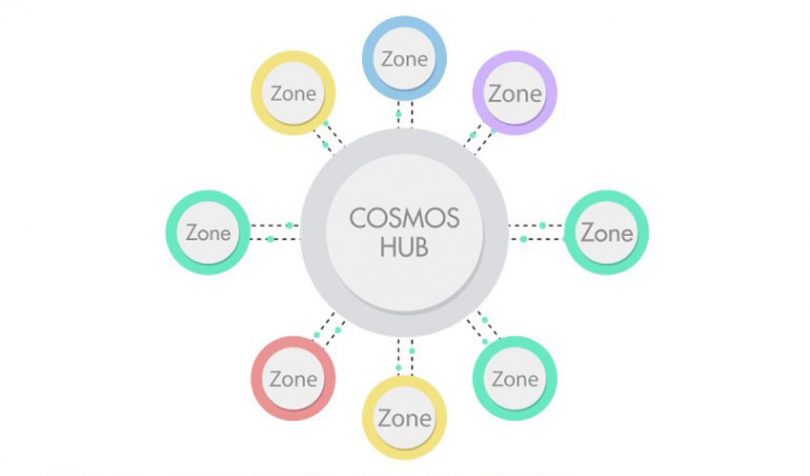Amongst all the hype in the cryptocurrency space, a handful of permissionless initiatives stand out such as Polkadot and DFINITY. Cosmos is one of them, and the network officially went live late last night. Cosmos tackles many of the issues that plague public blockchains, including three of the biggest: scalability, interoperability and finality. But Cosmos isn’t a single blockchain, it’s a network of blockchains. And some of those blockchains can be private.
Interoperability
The need for blockchains to technically interoperate is an issue that’s starting to rear its head. Cosmos has a Hub which is the core network. Every other blockchain network is called a zone and connects into the Cosmos Hub to enable interoperability. The beauty of the zones is they are independent. So each zone or blockchain can have its own governance and even be private. The primary requirement is that every zone must support Cosmos’ InterBlockchain Communication Protocol (IBC).
So what’s it good for? Cosmos can be used to enable two different networks or applications to talk to each other. For example, a trade finance network can interact with an insurance network. It can enable an essentially private network to use a token.
Another possibility is to use Cosmos as a bridge. The Agreements Network (AN) aims to enable legal contracts for businesses using smart contracts to trigger payments. There’s an AN permissioned network where lawyers create and upload legal contract templates. But there’s also an Ethereum application to enable payments. The two networks talk to each other using Cosmos.
Cosmos is also being used for a decentralized cryptocurrency exchange (DEX). The advantage of decentralized exchanges is they avoid the honeypot appeal that has encouraged so many exchange hacks. Binance, the largest exchange is launching a DEX using Cosmos.
For enterprises, the existence of a technical interoperability solution is only one piece of the puzzle. Other interoperability issues include standards, governance and legislation. So Cosmos isn’t a magic solution because the Cosmos Hub is permissionless and hence there are potential governance and jurisdictional issues. It also doesn’t enable Hyperledger Fabric to talk to R3’s Corda. But there’s some potential for Fabric to Fabric solution.
Scalability and Finality
With Bitcoin and Ethereum special “mining” nodes use the energy-intensive Proof of Work (PoW) mechanism to prevent fake participants from creating transactions. PoW is the culprit for the scalability challenges that plague many cryptocurrencies. One attempt to address the issue is by processing some transactions off-chain.
Another solution is to use an alternative approach called Proof of Stake (PoS), towards which Ethereum is softly-softly planning to move. PoS involves people risking or staking amounts of cryptocurrency. Cosmos isn’t the first blockchain to go live with Proof of Stake given the fifth highest market cap cryptocurrency EOS uses it as well.
The net effect is that Cosmos can process thousands of transactions per second.
The other side effect of PoW is the slow transaction finality. When using Ethereum, to be sufficiently confident that a transaction won’t be reversed one has to wait six minutes and even then it’s not guaranteed. For most real-world situations that’s simply impractical. On Cosmos, there’s instant finality.
Credibility
Cosmos uses the Tendermint consensus mechanism, by which nodes or servers on the network agree on transactions and their order. If the name Tendermint sounds familiar, that’s because it’s the name of one of the very first permissioned blockchain solutions, before the days of Hyperledger Fabric.
The new network shares the same founders as Tendermint led by respected CEO Jae Kwon. Compared to other cryptocurrency CEOs, Kwon is comparatively low key and the team has focused on execution.
Cosmos ran an ICO in early 2017 before it was fashionable. They put a cap on the fundraising and secured $16.8 million in half an hour. The token is called an Atom.
As we enter the dawn of the Space Age and exit the Wild West of blockchains with the launch of Cosmos, the time to exercise basic safekeeping of your Atoms has never been more critical.
?️Here's a guideline to defend against myriad attack vectors.https://t.co/xPu2QEJ6cQ
— Cosmos – the Internet of Blockchains (@cosmos) March 13, 2019
Generally, the team has a more conservative approach compared to others. More than a month ago it published a blog post warning about the risks during the network launch. “The Cosmos Hub is highly experimental software. In these early days, we can expect to have issues, updates, and bugs. The existing tools require advanced technical skills and involve risks which are outside of the control of the Interchain Foundation and/or the Tendermint team.”
As with most new blockchains, there’s a good chance Cosmos will encounter issues during the early days.
But the network also enables Ethereum applications to port to Cosmos by using Ethermint. For those constrained by Ethereum’s performance, Cosmos could quickly prove attractive.
Useful links:
Whitepaper: https://cosmos.network/resources/whitepaper
Overview: https://blog.cosmos.network/understanding-the-value-proposition-of-cosmos-ecaef63350d
No member of the Ledger Insight’s team owns Atom tokens

